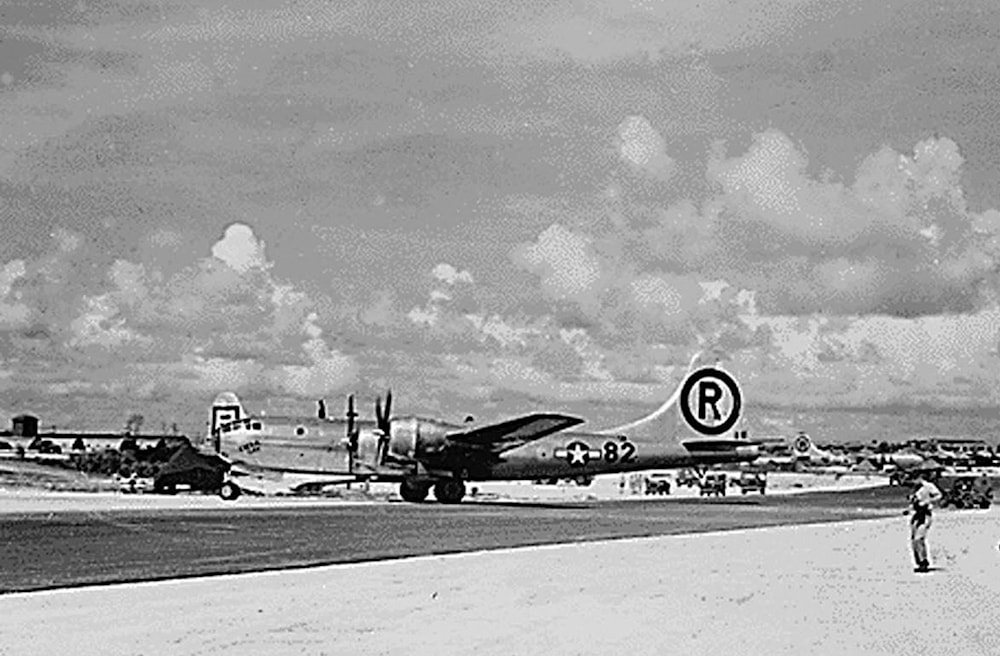Tinian resurrection: US reviving WWII airfield amid Pacific tensions
A PACAF spokesperson says US military projects for "fuel and airfield development" at the Tinian island's nearby civilian airport are already underway.
-

This file photo from the National Archives taken 6 August 1945, shows the B-29 plane Enola Gay after landing on Tinian Island from its mission to drop the first Atomic bomb over Hiroshima, Japan. (THE NATIONAL ARCHIVES/AFP)
In the middle of the Pacific Ocean, Tinian Island Airfield, an abandoned US airfield from the World War II era that was once key to dropping the nuclear bomb on Japan, is being revived.
"Rehabilitation of World War II-era airfields has provided Pacific Air Forces (PACAF) a rapidly executable avenue to enhance infrastructure in the region," a spokesperson told AFP.
Though the statement mentioned a "sense of urgency" enabling PACAF to "enhance... warfighting capability and improve deterrent posture alongside Allies and partners," it did not mention China directly, the news agency pointed out.
It is noteworthy that the US Department of Defense's 2022 planning document, called the National Defense Strategy, reads that "the most comprehensive and serious challenge to US national security is the (People's Republic of China's) coercive and increasingly aggressive endeavor to refashion the Indo-Pacific region and the international system to suit its interests and authoritarian preferences."
Tinian's old military airfield "has extensive pavement underneath the overgrown jungle. We'll be clearing that jungle out between now and summertime," Air Force General Kenneth Wilsbach recently told Japanese outlet Nikkei Asia.
Meanwhile, military projects for "fuel and airfield development" at the island's nearby civilian airport are already underway, according to the PACAF spokesperson.
According to AFP, the airfield at Tinian was perhaps the most important -- and the busiest -- in the world in 1945, as its six runways hosted US B-29 bombers carrying out attacks against Japan, some 1,500 miles (2,300 kilometers) away.
On August 6 and August 9 of that year, the planes dropped nuclear bombs on Hiroshima and Nagasaki, killing some 200,000 people.
In the last three years, money annually allocated to Indo-Pacific military construction costs has doubled from $1.8 billion in 2020 to $3.6 billion in 2023, a recent report from the Congressional Research Service (CRS) shows.
It's part of a Pentagon strategy to open a range of flexible military bases, able to operate outside of the larger, longstanding installations in Japan, South Korea, and the American island territory of Guam.
On Tinian, initial work started near the civilian airport in February 2022, before extending toward the World War II airfield north of the island.
Within two years, tarmac rehabilitation and the construction of fuel tanks are set to be completed, at a budget of at least $162 million, part of contingency plans in the event "access to Andersen Air Force Base or other western Pacific locations is limited or denied," according to Air Force financial documents reviewed by AFP.
Tinian isn't the only World War II-era base being revamped: new defense appropriations also include money for construction at Basa Air Base in the Philippines, "along with ongoing projects" at the Royal Australian Air Force's Darwin and Tindal bases, the PACAF spokesperson noted.
Satellite images already show the extent of the work underway, including a new tarmac built just north of the Tinian airport, AFP mentioned.
Read more: Top US, China officials talk for first time in over a year

 3 Min Read
3 Min Read








